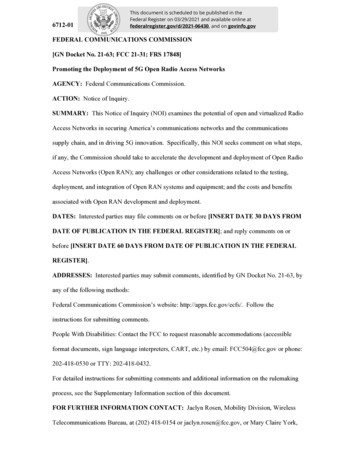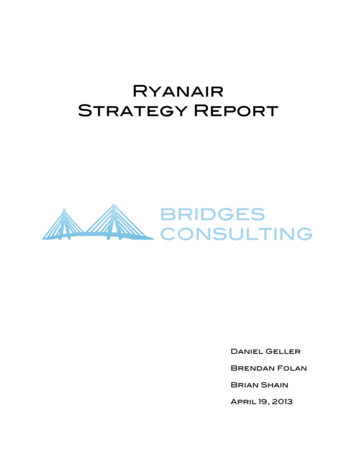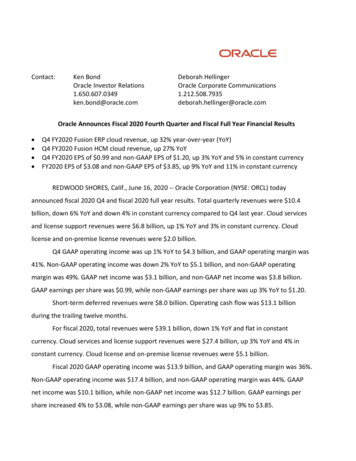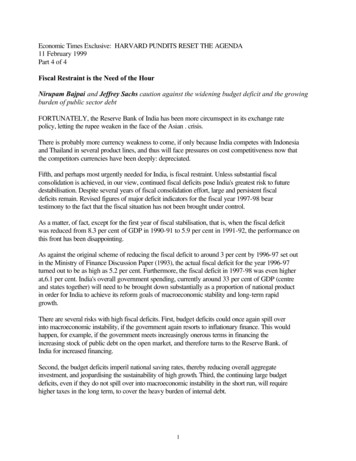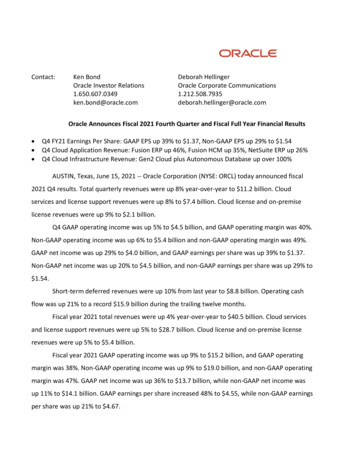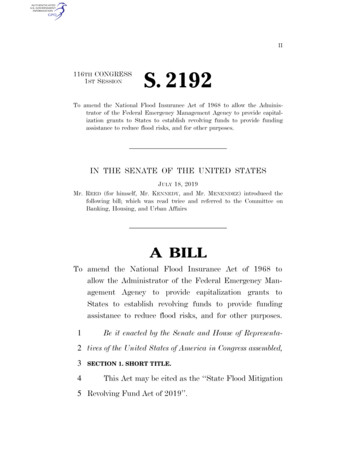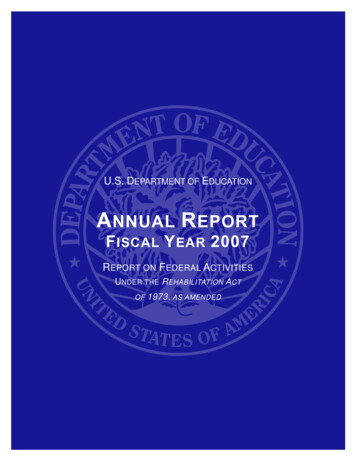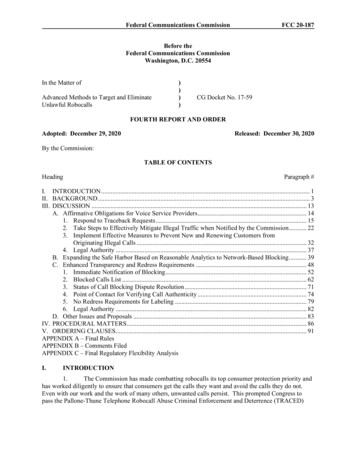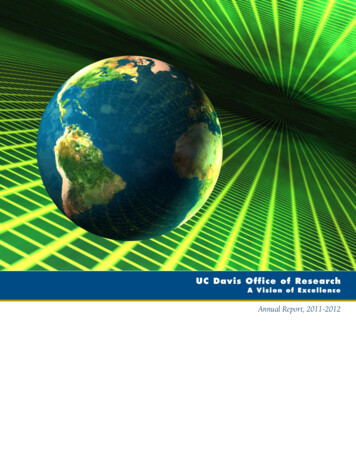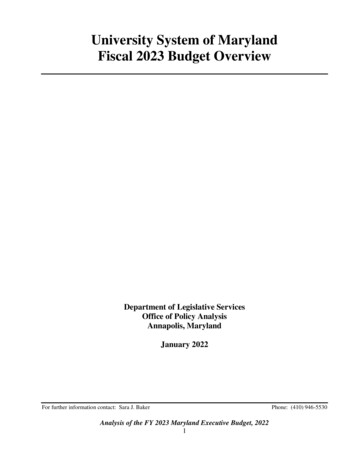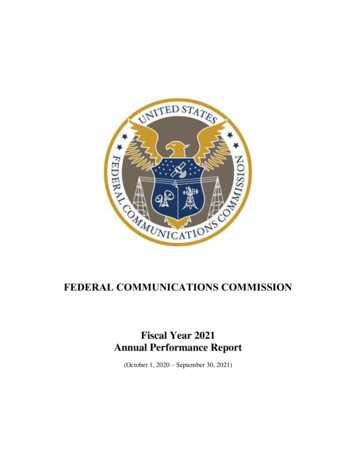
Transcription
FEDERAL COMMUNICATIONS COMMISSIONFiscal Year 2021Annual Performance Report(October 1, 2020 – September 30, 2021)
Message from the ChairwomanAs Chairwoman of the Federal Communications Commission (FCC or Commission), it is my pleasure topresent the FCC’s Annual Performance Report for Fiscal Year (FY) 2021. At the outset, pleasenote that the FCC’s FY 2021 Annual Performance Report reflects the strategic and performancegoals included in the FCC’s FY 2021 Budget proposal, which contained the FCC’s FY 2021performance plan, and which was submitted to Congress prior to my tenure as the FCC's agencyhead.Pursuant to the GPRA Modernization Act of 2010, P.L. 111-352, and Office of Management andBudget (OMB) Circular A-11, the FCC has updated its strategic and performance goals since thepresidential transition in January of 2021 to reflect the priorities of the administration of the FCCunder my leadership. The new strategic goals, which can be found in the FCC’s Strategic Plan forFY’s 2022 – 2026, include: Pursue a 100% Broadband Policy; Promote Diversity, Inclusion,Equity and Accessibility; Empower Consumers; Enhance Public Safety and National Security;Advance America’s Global Competitiveness; and Foster Operational Excellence. For additionalinformation on the FCC's new goals, please see the FCC's Strategic Plan for FY’s 2022-2026,which is available at: uring FY 2021, the Commission mounted an extraordinary response to a historic crisis. The FCCworked on a bipartisan basis to set up the Nation’s largest-ever broadband affordability program,the Emergency Broadband Benefit (EBBP), which helped millions of households afford internetaccess during the pandemic before its completion on December 31, 2021. The FCC has nowlaunched the Affordable Connectivity Program, the 14.2 billion successor program to EBBP, andhas already surpassed 10 million households enrolled. The Commission looks forward to reportingon its accomplishments in future years.In addition, the Commission launched the Emergency Connectivity Fund, the first nationwideeffort to close the Homework Gap so no child is left offline. Through this program, school-agedchildren have access to over 8.9 million connected devices that will help them keep up with theirschoolwork and develop the skills they need for success in the digital age. Furthermore, over thepast year, the Commission has made historic investments in telehealth technology across thecountry and healthcare centers nationwide that are receiving much needed funding support to assistwith efforts to expand telehealth.In FY 2021, the FCC made incredible strides towards helping the American public through thispandemic. Throughout the year, the Commission worked diligently towards achieving its missionacross all of its strategic goals, and I am pleased to present this Annual Performance Report tohighlight the Commission’s wide array of accomplishments during FY 2021.Jessica RosenworcelChairwoman2
MissionAs specified in section one of the Communications Act of 1934, as amended, the FederalCommunications Commission’s (FCC’s or Commission’s) mission is to “make available, so far aspossible, to all the people of the United States, without discrimination on the basis of race, color,religion, national origin, or sex, rapid, efficient, Nation-wide, and world-wide wire and radiocommunication service with adequate facilities at reasonable charges.”1 In addition, section oneprovides that the Commission was created “for the purpose of the national defense” and “for thepurpose of promoting safety of life and property through the use of wire and radiocommunications.”2About the Federal Communications CommissionThe FCC is an independent regulatory agency of the United States Government. The FCC ischarged with regulating interstate and international communications by radio, television, wire,satellite, and cable. The Commission also regulates telecommunications and advancedcommunication services and video programming for people with disabilities, as set forth in varioussections of the Communications Act.The FCC is directed by five Commissioners, who are appointed by the President and confirmedby the Senate for five-year terms, except when filling the unexpired term of a previousCommissioner. Only three Commissioners can be from the same political party at any given time.The President designates one of the Commissioners to serve as Chairman.The FCC is organized by function. There are seven Bureaus and ten Offices. The Bureaus andthe Office of Engineering and Technology process applications for licenses to operate facilitiesand provide communications services; analyze complaints from consumers and other licensees;conduct investigations; develop and implement regulatory programs; and organize and participatein hearings and workshops. Generally, the Offices provide specialized support services. TheBureaus and Offices are: 12The Consumer & Governmental Affairs Bureau develops and implements consumerpolicies, including disability access and policies affecting Tribal nations and state and localgovernments. The Bureau also serves as the public face of the Commission through outreachand education and responds to consumer inquiries and informal complaints. The Bureaumaintains collaborative partnerships with consumer-facing organizations and state, local, andTribal governments in such areas as implementation of critical initiatives, implementation ofnew technologies, and emergency preparedness. In addition, the Bureau’s Disability RightsOffice provides expert policy and compliance advice on accessibility with respect to variousforms of communications for persons with disabilities. The Bureau also ensures public facingaccess to the Commission for persons with disabilities via a team of American Sign Languageinterpreters and accessible formats specialists.47 U.S.C. § 151.Id.3
The Enforcement Bureau enforces the Communications Act and the FCC’s rules. It acts toprotect consumers, ensure efficient use of spectrum, further public safety, promotecompetition, resolve disputes, and protect the integrity of FCC programs and activities fromfraud, waste, and abuse. The International Bureau administers the FCC’s international telecommunications andsatellite programs and policies, including licensing and regulatory functions. The Bureaupromotes pro-competitive policies abroad, coordinates the FCC’s global spectrum activities,and advocates for U.S. interests in international communications and competition. The Bureauworks to promote high-quality, reliable, interconnected, and interoperable communicationsinfrastructure on a global scale. The Media Bureau recommends, develops, and administers the policy and licensing programsrelating to electronic media, including broadcast, cable, and satellite television in the UnitedStates and its territories. The Public Safety and Homeland Security Bureau develops and implements policies andprograms to strengthen public safety communications and interoperability, homeland security,national security, emergency management and preparedness, disaster management, andnetwork reliability and resiliency. These efforts include rulemaking proceedings that promotemore efficient use of public safety spectrum, improve public alerting mechanisms, enhance thenation’s 911 emergency calling system, and establish frameworks for communicationsprioritization during crises. The Bureau also maintains 24/7 operations capability andpromotes Commission preparedness to assist the public, first responders, the communicationsindustry, and all levels of government in responding to emergencies and major disasters wherereliable public safety communications are essential. Finally, the Bureau coordinates theCommission’s national security mission and consults with the Defense Commissioner pursuantto 47 CFR § 0.181 of the Commission’s rules. The Wireless Telecommunications Bureau is responsible for wireless telecommunicationsprograms and policies in the United States and its territories, including licensing and regulatoryfunctions. Wireless communications services include cellular, paging, personalcommunications, mobile broadband, and other radio services used by businesses and privatecitizens. The Wireline Competition Bureau develops, recommends, and implements policies andprograms for wireline telecommunications, fixed (as opposed to mobile) broadband andtelephone lines, striving to promote the widespread development and availability of theseservices. The Bureau has primary responsibility for the Universal Service Fund which helpsconnect all Americans to communications networks. The Office of Administrative Law Judges is composed of one judge (and associated staff)who presides over hearings and issues decisions on matters referred by the FCC.4
The Office of Communications Business Opportunities promotes diversity, competition andinnovation in the provision and ownership of telecommunications and information services bysupporting opportunities for small businesses as well as women-owned and minority-ownedcommunications businesses. The Office of Economics and Analytics provides objective economic analysis to supportCommission policy making and implements agency-wide data practices and policies, includingimplementing significant economically-relevant data collections. The Office also manages theFCC’s auctions in support of and in coordination with the FCC’s Bureaus and Offices. The Office of Engineering and Technology advises the FCC on technical and engineeringmatters. This Office develops and administers FCC decisions regarding spectrum allocationsand unlicensed devices and coordinates use of the spectrum with the Executive Branch. TheOffice also oversees the Commission’s equipment authorization program to ensure compliancewith technical rules and its experimental licensing program to promote new and innovativetechnologies and services. The Office of the General Counsel serves as the FCC’s chief legal advisor. The Office of the Inspector General conducts and supervises audits and investigationsrelating to FCC programs and operations. The Office of Legislative Affairs serves as the liaison between the FCC and Congress, as wellas other Federal agencies. The Office of the Managing Director administers and manages the FCC. The Office of Media Relations informs the media of FCC decisions and serves as the FCC’smain point of contact with the media. The Office of Workplace Diversity develops, coordinates, evaluates, and recommends to theCommission policies, programs, and practices that foster a diverse workforce, and promotesand ensures equal employment opportunity (EEO) for all employees and applicants withoutregard to race, color, religion, sex (including pregnancy and gender identity), sexualorientation, national origin, age, disability (mental, intellectual, or physical), marital status,parental status, political affiliation, genetic information (including medical history), or anyother basis protected by law.5
CLOSING THE DIGITAL DIVIDEDevelop a regulatory environment to encourage the private sector to build, maintain, andupgrade next-generation networks so that the benefits of advanced communications services areavailable to all Americans. Where the business case for infrastructure investment doesn’t exist,employ effective and efficient means to facilitate deployment and access to affordablebroadband in all areas of the country.FY 2021 PERFORMANCE HIGHLIGHTSA key priority for the FCC is to close the digital divide in rural America. The FCC used severalmechanisms and funding models to increase broadband service in rural areas, including the RuralDigital Opportunity Fund, the Emergency Connectivity Fund, the COVID-19 Telehealth Program,the Emergency Broadband Benefit Program, and the Connected Care Pilot Program.Rural Digital Opportunity FundThe FCC moved forward with funding new broadband deployments through the Rural DigitalOpportunity Fund by authorizing over 311 million in broadband funding across thirty six statesand as of September 30, 2021, the Commission has obligated 136 million of the amountauthorized. The FCC also took steps to clean up issues with the program’s design originating fromits adoption in 2020. As a result of this funding authorization, forty eight broadband providerswill bring 1 Gbps broadband speeds to nearly 200,000 homes and businesses over the next 10years.Emergency Connectivity FundThe FCC adopted rules implementing the 7.17 billion program, funded by the American RescuePlan Act of 2021, which enables schools and libraries to purchase laptop and tablet computers,Wi-Fi hotspots, and broadband connectivity for students, school staff, and library patrons in needduring the COVID-19 pandemic. For the first application filing window (June 29, 2021 throughAugust 13, 2021), the FCC received requests for 5.137 billion to fund 9.1 million connecteddevices and 5.4 million broadband connections that will be received or delivered between July 1,2021 and June 30, 2022. The first filing window attracted applications from all 50 states, AmericanSamoa, Guam, Northern Mariana Islands, Puerto Rico, U.S. Virgin Islands and the District ofColumbia – including schools and libraries in both rural and urban communities.As of September 30, 2021, the FCC has committed over 1.2 billion for 3,040 schools, 260libraries, and 24 consortia that applied for support from the Emergency Connectivity FundProgram. The first wave of funding commitments will provide students, school staff, and librarypatrons in all 50 states and Guam, Puerto Rico, and the District of Columbia access to the devicesand broadband connectivity they need to support their off-campus education needs. The first waveof funding will also support 3,081,131 devices and 774,115 broadband connections and helpconnect over 3.6 million students who would otherwise lack access.6
COVID 19- Telehealth ProgramThe FCC approved a total of over 165 million in funding applications for Round 2 of its COVID19 Telehealth Program, a 249.95 million federal initiative that builds on the 200 million programestablished as part of the Coronavirus Aid, Relief, and Economic Security (CARES) Act. TheFCC has so far approved 280 applications to receive Round 2 funding. The program supports theefforts of health care providers to continue serving their patients by providing telecommunicationsservices, information services, and connected devices necessary to enable telehealth during theCOVID-19 pandemic.Emergency Broadband Benefit ProgramAs of September 30, 2021, over six million households have enrolled in the Emergency BroadbandBenefit Program since its launch in mid-May. The Emergency Broadband Benefit Program is a 3.2 billion federal initiative to provide qualifying households discounts on their internet servicebills and an opportunity to receive a discount on a computer or tablet. This program provideseligible households with discounts of up to 50 a month for broadband service, and up to 75 amonth if the household is on Tribal lands. It also provides a one-time discount of up to 100 on acomputer or tablet for eligible households. The Commission has now transitioned from theEmergency Broadband Benefit Program to the new 14.2 billion Affordable Connectivity Programeffective December 31, 2021.Connected Care PilotThe FCC approved a Report and Order offering guidance on the administration of the 100 millionConnected Care Pilot Program, including guidance on eligible services, competitive bidding,invoicing, and data reporting for selected participants. As of September 30, 2021, the FCC hadapproved 57 million in funding for 59 pilot projects serving patients in 30 states plus Washington,DC.Updating E-Rate RulesThe FCC proposed revisions to the definition of library in the E-Rate program rules to provideclarity regarding the eligibility of Tribal libraries and to promote increased participation ofunderrepresented Tribal libraries in the E-Rate Program. Certain Tribal libraries have been unableto participate and receive support from the program, which provides discounts on broadbandservices and internal connections to schools and libraries, because they did not qualify under anoutdated definition of a library included in the 1996 version of the Library Services andTechnology Act that was adopted in the Commission’s rules. The FCC’s proposed revisions willremove this outdated reference from its rules, align the eligibility requirements between the E-Rateand Emergency Connectivity Fund Programs, and promote the increased participation of Triballibraries by making it clear they are eligible to receive support through the E-Rate Program.7
Broadband Data CollectionDuring the reporting period, the FCC accomplished a number of critical milestones in thedevelopment and implementation of the Broadband Deployment Accuracy and TechnologyAvailability Act (Broadband DATA Act) that will enable it to produce precise and consistent mapsof broadband availability to ensure that federal, state, and local resources can be targeted to connecteveryone, everywhere to high-speed, reliable broadband service. In January 2021 the FCCadopted the Third Report and Order in the Broadband Data Collection proceeding, specifyingwhich fixed and mobile broadband Internet access service providers are required to reportbroadband availability data and expanding the reporting and certification requirements for certainfixed and mobile broadband filers. The Third Report and Order also adopted standards forverifying mobile data and collecting verified broadband data from state, local, and Tribal entitiesand certain third parties and adopted processes for submitting challenges to fixed and mobilecoverage map data and data in the Broadband Serviceable Location Fabric (Fabric), along withprocesses for providers to respond to such challenges. In addition, the Third Report and Orderestablished standards for identifying locations that will be included in the Fabric and forenforcement of the requirements associated with the Broadband Data Collection.In February 2021, Chairwoman Rosenworcel established the Broadband Data Task Force (TaskForce) to lead the cross-agency effort to implement improvements to the FCC’s broadband dataand mapping tools. Since then, the Task Force, working closely other FCC Bureaus and Offices,has passed multiple significant milestones essential to fully implement the Broadband DATA Act.Specifically, the FCC has: Coordinated with the United States Postal Service (USPS) to develop and execute a pilotprogram to test the feasibility of partnering with federal agencies that operate delivery fleetvehicles, including the USPS, to supplement and verify the broadband deployment andavailability data. Pursuant to the Broadband DATA Act, the FCC submitted a report toCongress on this pilot program on May 24, 2021.Awarded a Data Architect and Design Services contract to develop a framework for thedata flow of the complex, interrelated systems associated with the Broadband DataCollection (BDC). On July 2, 2021, the FCC awarded a follow-on contract for the BDCsystem design and implementation.Initiated a competitive procurement process for the creation of the Fabric, a commondataset of all locations in the United States where fixed broadband Internet access servicecan be installed. This competitive bidding process was specifically required in theBroadband DATA Act. The FCC expects to conclude the competitive bidding process inFiscal Year 2022.Executed an interagency agreement with the National Telecommunications andInformation Administration (NTIA) and the United States Department of Agriculture(USDA) to share information about and coordinate the distribution of federal broadbanddeployment funds under the FCC’s high-cost programs, Rural Utilities Service programsat USDA, and NTIA programs.Released a detailed public notice (PN), technical appendix, and proposed rules seekingcomment on the technical requirements for the mobile challenge, verification, and8
crowdsource processes required by the Broadband DATA Act. FCC staff hosted a webinaron August 12 during which staff discussed the proposed details for the challengeprocess and verification methodologies and responded to questions from stakeholders priorto the deadline for filing comments and reply comments. Staff are reviewing the recorddeveloped in response to the PN and anticipate an order in Fiscal Year 2022.Executed a contract modification to develop the additional functionality for the FCC SpeedTest app to be used for the mobile challenge and crowdsource processes.Launched a new webpage – www.fcc.gov/BroadbandData – to serve as a central locationfor information about the Broadband Data Collection. The webpage also provides accessto a new portal through which consumers can share their experiences with broadbandservices in their area. The FCC has received over 13,000 submissions through the portal.Released a new, first-of-its-kind map showing 4G LTE broadband and voice coverage forthe country’s four largest mobile carriers. The four carriers used the new BDC propagationmodel parameters to submit their 4G LTE broadband and voice coverage data as of May15, 2021, as a part of their semi-annual Form 477 submission. The maps rendered by theFCC from this data provide the public a preview of how the mobile data to be collected asa part of the BDC will look, and the FCC will also use this data to assist in its ongoingefforts to develop and test the BDC systems and platforms.PROMOTING INNOVATIONFoster a competitive, dynamic, and innovate market for communications services throughpolicies that promote the introduction of new technologies and services. Ensure that the FCC’sactions and regulations reflect the realities of the current marketplace, promoteentrepreneurship, expand economic opportunity, and remove barriers to entry and investment.FY 2021 PERFORMANCE HIGHLIGHTSThe FCC took several actions to make additional spectrum available for 5G deployment: The FCC has taken a number of actions related to the 4.9 GHz (4940-4990 MHz) band,which is licensed exclusively to public safety agencies and private entities that supportthem. First, it issued a stay of the rules adopted in September 2020, which would haveallowed non-public use of the band through a state-by-state leasing framework. Next, itvacated the order adopting those rules and issued a Further Notice of Proposed Rulemaking(FNPRM) seeking comment on alternate means of increasing use of the band whileprotecting public safety operations.The FCC made mid-band spectrum in the 3.45-3.55 GHz band available for auction byreallocating 100 megahertz in the 3.45 GHz band for flexible use wireless services. TheFCC also adopted procedures for Auction 110, in which the spectrum was divided into ten10-megahertz blocks licensed by geographic areas known as Partial Economic Areas(PEAs). Bidding in Auction 110 began in October 2021.The Wireless Telecommunications Bureau (WTB) granted 237 applications for PriorityAccess Licenses won in the 3.5 GHz auction (Auction 105). These applications represent9
17,601 Priority Access Licenses. Subsequently, 13 additional applications were granted,representing 125 licenses.WTB granted 5,676 licenses in the 3.7 GHz service (3.7 to 3.98 GHz, also referred to asthe C-band) following completion of Auction 107.WTB and the Office of Engineering and Technology took seven actions related to 3.5 GHzEnvironmental Sensing Capability (ESC) and Spectrum Access Systems (SAS) approvals,including approving new SAS and ESCs, expanding the geographic scope of existing SASand ESC authorizations, and approving new ESC sensor deployments.WTB reviewed nearly 400 applications in the Commission’s 2.5 GHz Rural Tribal PriorityWindow, which provided an opportunity for federally recognized Tribes and Alaska NativeVillages to apply for spectrum in the 2.5 GHz band. Further, the Office of Economics andAnalytics (OEA) and WTB proposed bidding procedures for Auction 108 in which countywide overlay licenses for unused spectrum in the 2.5 GHz band will be offered.By the end of September 2021, WTB staff had:o Accepted a total of 319 applications for filing, through six Accepted for Filing(AFF) Public Notices (September 2020, November 2020, January 2021, April2021, July 2021, September 2021).o Granted 272 applications.o Issued individual orders granting waivers of the eligibility rules applicable to theTribal Priority Window to sixteen applicants.In September, 2021, WTB issued a Public Notice encouraging Rural Tribal PriorityWindow applicants to cooperate to voluntarily resolve mutual exclusivity betweenapplications in order to expedite action on remaining applications.During the review of the applications, from October 2020 through the end of September2021, WTB staff conducted extensive outreach including hundreds of telephone calls toTribal applicants to seek additional information in connection with applications andrespond to inquiries.The FCC took the next step in its Partitioning, Disaggregation and Leasing Spectrumproceeding, releasing a FNPRM that proposes the creation of an Enhanced CompetitionIncentive Program to further encourage current spectrum licensees to enter into secondarymarket transactions with Tribal Nations and small providers.The FCC adopted a spectrum allocation for the 2200-2290 MHz band to bolster the U.S.commercial space industry’s access to spectrum needed for successful rocket launches. Thisallocation lays the groundwork for giving private space travel and satellite launch companiesaccess to spectrum in the band for transmissions from space launch vehicles during pre-launchtesting and space launch operations. The FCC also sought comment on the potential use of the420-430 MHz, 2025-2110 MHz, and 5650-5925 MHz bands for space launch operations, as wellas on appropriate licensing and technical rules for each band.The FCC issued a Notice of Proposed Rulemaking (NPRM) seeking comment on how to maximizeefficient use of 500 megahertz of spectrum between 12.2-12.7 GHz (12 GHz band), which in theUnited States is allocated on a primary basis for non-Federal Direct Broadcast Satellite (DBS),non-geostationary Fixed Satellite Service (NGSO FSS), and Fixed Service. The item sought10
comment on whether and how the Commission’s rules might allow for terrestrial flexible use,including two-way mobile service, in the 12 GHz band, given the presence of incumbent uses andallocations.The FCC adopted rules to increase opportunities for unlicensed white space devices to operate onbroadcast television channels and expand wireless broadband connectivity in rural andunderserved areas.The FCC repurposed 45 megahertz in the 5.850-5.925 GHz band (5.9 GHz band) for the expansionof unlicensed mid-band spectrum operations. The FCC decision retained 30 megahertz ofspectrum in the 5.9 GHz band for intelligent transportation system (ITS) operations to meet currentand future ITS needs within the transportation and vehicular-safety related ecosystem and providedunlicensed access to an additional 45 megahertz of mid-band spectrum to help meet the growingdemand for wireless broadband.The FCC’s Office of Engineering and Technology began the process to authorize use of 6 GHzBand Automated Frequency Coordination Systems to facilitate standard-power unlicensedoperations in this mid-band spectrum in addition to indoor low-power operations.The FCC updated its radio frequency device marketing and importation rules to accelerate thetimeframe for developing and releasing new wireless devices. The rules will give innovators moreflexibility to engage in crowdfunding and other popular marketing campaigns and, in specificcases, to import devices still under equipment authorization review. The updated rules permitimportation of up to 12,000 devices for certain pre-sale activities and permit conditional sales ofdevices to consumers prior to the devices obtaining equipment authorization.The FCC proposed to add a co-primary allocation for geostationary-satellite orbit (GSO) FSS inthe space-to-Earth (downlink) direction in the 17.3-17.7 GHz band and to permit limited GSO FSS(downlink) use of the 17.7-17.8 GHz band on a non-protected basis with respect to fixed serviceoperations. The proposal would increase intensive and efficient use of the band and provideadditional downlink capacity for high-throughput satellite communications.Throughout the year, the FCC conducted an extensive information and outreach campaign in orderto update its C-Band earth station records and ensure a successful Phase I of a multi-year transitionof approximately 20,000 earth stations out of 3.7-3.98 GHz, which is clearing 300 megahertz for5G service, without disrupting the consumer programming services that traditionally have reliedon use of the C-Band.The FCC adopted new sponsorship identification requirements to require broadcasters to disclosewhen foreign governments or their representatives lease time on their airwaves.The FCC sought comment on updated rules to stimulate the development of new products andservices in the 60 GHz spectrum band, recognizing the increasing practicality of using mobileradar devices in the 60 GHz band to perform innovative and life-saving functions, includinggesture control, detection of unattended children in vehicles, and monitoring of vulnerable medical11
patients. The Office of Engineering and Technology also issued eleven waivers to permit 60 GHzband radars to be used for automotive safety applications.The FCC sought comment on allowing Wireless Multi-Channel Audio Systems (WMAS), on alicensed basis in frequency bands where wireless microphones already are currently authorized.WMAS is an emerging wireless microphone technology that would enable more microphones permegahertz of spectrum, an efficiency that can benefit music venues or convention centers withmultiple performers o
promotes pro-competitive policies abroad, coordinates the FCC's global spectrum activities, and advocates for U.S. interests in international communications and competition. The Bureau works to promote high-quality, reliable, interconnected, and interoperable communications infrastructure on a global scale.
